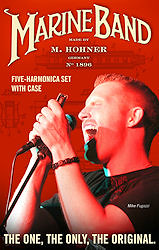Miles Dewar
686 posts
Feb 02, 2011
4:58 PM

|
$80.oo per harmonica and you will NEVER have to learn how to Overblow or Overdraw. Hit them cleanly The Very First Time You Play It.
Although you have to play it like a piper running rats around your city.
http://www.suzukimusic.com/harmonicas/mr300/
|
OzarkRich
378 posts
Feb 02, 2011
5:26 PM

|
I came across my overdrive (F) this afternoon. My dad bought it a few years ago and didn't like it. I had just taken it apart and cleaned it and then saw this thread.
I never did get the hang of it. It's hard to play normal without accidentally covering the holes. On a plus side it has thick, crush-resistant, rounded covers and slides in a pocket easily.
----------
Ozark Rich

__________
##########
Ozark Rich's YouTube
Ozark Rich's Facebook
|
RyanMortos
1005 posts
Feb 02, 2011
6:03 PM

|
Hmmm, at least I like the image at the bottom of the page that illustrates what is happening:

----------

~Ryan
"I play the harmonica. The only way I can play is if I get my car going really fast, and stick it out the window." - Stephen Wright
Pennsylvania - H.A.R.P. (Harmonica Association 'Round Philly)
Contact:
My youtube account
|
tmf714
460 posts
Feb 02, 2011
6:24 PM

|
I own the MR-300 and it is one of the loudest harps I own-including my customs-it overblows and overdraws much easier than any OTB harp.
|
Miles Dewar
688 posts
Feb 02, 2011
8:04 PM

|
Speaking of Suzuki... Has anyone seen their "Fabulous" series of Chromatics?
$3,900.oo Of Fabulousness
I think the diatonics are around $150.00-$300.oo
|
HarpNinja
1061 posts
Feb 03, 2011
6:29 AM

|
I have one of these and didn't think the OBs sounded better than on a traditional harp. Easier to play from a mouth standpoint, yes. Easier to play in general, no. The finger dancing is tricky and it would be difficult to play amped harmonica with it, IMO.
----------
Mike
Quicksilver Custom Harmonicas
Updated 2/1/11

|
Miles Dewar
689 posts
Feb 03, 2011
6:58 AM

|
Mike, The fingerdancing is what I thought would make it pointless.
|
tmf714
461 posts
Feb 03, 2011
8:46 AM

|
From Pat Missin-
In "normal" play (ie, without overblows) the harp responds very well. It is very loud and the individual cover chambers give a rich, penetrating tone, perfect for cutting through noisy sessions. They also help players with small hands get those heavily cupped tonal changes obtained by Rice Miller (SBWII) and other big-handed blues players. The tuning is equal temperament, typical of most far Eastern harps and is fairly accurately tuned at about A=444. The reeds themselves look similar to those used on the Suzuki BluesMaster - they seem to have good tolerances and are tuned without the diagonal file marks that certain factories inflict upon their reeds. It is possible to give the lowest draw reeds a very hard attack without causing them to rattle against the lower cover, as on many lower keyed diatonics. Several people have described this as one of the best factory-made harps they have ever played and I think I must agree.
|
tmf714
462 posts
Feb 03, 2011
8:48 AM

|
More from Pat-
However, if you are courageous enough to sacrifice the security of the maker's guarantee, there is something you can do to help fix some of the above-mentioned problems. One evening, whilst trying out some different reedplates with the MR-300 comb and covers, I wondered what would happen if I were to replace one of the covers with a standard Marine Band coverplate. (Because the reedplates of the MR-300 are not designed to be exposed to the lips, adding the Marine Band upper cover made the harp a bit uncomfortable to play.) I immediately noticed something - all of a sudden I could hit the hole 10 overdraw quite easily without blocking the appropriate hole in the lower cover (although the note sounded much cleaner if I did block that hole). Previously, that note had been almost impossible for me to hit on the D MR-300. I quickly assembled the harp with the upper cover of the Overdrive and the lower cover of a Marine Band and I found that I could now readily play overblows in the "normal" fashion (although again, they were much stronger with the upper cover holes blocked) and the hole 1 overblow which had proved so elusive when I first tried out the harp, now came quite easily. Even better, the draw bends in holes 2 and 3 had lost their tendency to become unstable at the lower limit of the bends. After pondering this for a while, I realised that the additional reed chambers were only really necessary for holes 1-6 blow (the upper cover) and holes 7-10 draw (the lower cover). I mentioned this to a friend of mine, who drew my attention to a posting on harp-l that I must have overlooked. Masaru Hashimoto (the engineer who designed the Overdrive for Suzuki) had arrived at a similar solution..
|
walterharp
531 posts
Feb 03, 2011
12:07 PM

|
it is pretty awkward to use those holes... xb-40 or a half-valved harp is a better route probably if you want to avoid the overblow/ overdraw thing
|